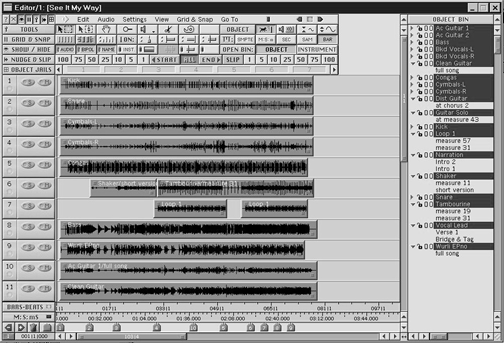
The Editor Window
While some DAWs approach the market with a simple one or two screen interface, PARIS goes the other way and offers about a dozen screens to access its large collection of features. Fortunately, most work is done in just a couple of the screens, the Editor Window and Mixer Window. The program loads to the Project Window first. Here you set such things as sample rates, SMPTE settings, record resolution (16 or 24-bit), the record file path, and other initial settings.
The Editor Window displays the system’s sixteen tracks horizontally on the Playing Field. Green LEDs to the left of each track indicate data on a track, and there are solo and mute buttons for each track. Recordings are shown as rectangular blocks or objects on the tracks and waveform displays inside the rectangles can be turned on to facilitate visual editing. Several time rulers at the bottom of the screen view time in a variety of ways including SMPTE code, bars/beats, seconds, samples, and minutes/seconds/milliseconds. The top portion of the window is loaded with tool bars. An elaborate Nudge/Slip bar makes moving objects in either direction on a track an accurate procedure when simple clicking and dragging isn’t enough. I really liked the Object Jails bar, which provides 32 audio clipboards for storing objects or groups of objects. This is a great place to store clips of music when building a bed for a concert spot, for example. Use the jails to store sound effects or audio you’ve edited out of a project but don’t want to necessarily throw away.
The Grid & Snap bar sets a grid on the Playing Field based on one of the time rulers available. Objects can then be set to snap to the grid, or they can snap to other objects. Clicking on an object selects it. Drawing a box around a group of objects selects the group. Moving objects around the Playing Field is a simple click/drag away. The Time Locked Selector Tool permits movement from track to track but locks the position in the time line. It also remembers where objects were when removed, so that placing them back on the Playing Field puts them in their exact position on the time line prior to removing them.
Tools such as the Time Locked Select tool are found on the Tools Bar along with tools for zooming, splitting objects, splicing objects, adjusting the waveform amplitude, and more. The Split Object tool’s icon is a pair of scissors. Click this, then click at any point on an object to cut or split it at that point. The Join Objects tool is represented with an icon that looks like a Scotch tape holder. It is used to connect objects cut with the Split Tool. To edit a word out of a voice track represented as a single object, locate the word in the object. Use the Split Object tool to cut on either side of the word. The word to be edited now becomes a separate object. Select it, then use the Clear and Close command from the Edit menu to perform a basic cut and splice. (There seems to be a step or two too many in this process, but keyboard commands speed the process somewhat.) All work done in the Editor Window is non-destructive, and PARIS offers up to 99 levels of undo.
The Object Bin is also part of the Editor Window and is basically an audio file manager to the right of the track display. Here, all the files associated with a project are listed for easy drag and drop manipulation. The Object Bin can be turned on and off and is a more streamlined version of the Audio Window which provides more options for dealing with the audio files.
PARIS provides extensive marker functions. The Marker Bar at the bottom of the Editor Window displays set markers and provides icons to move from marker to marker and set new markers, and there’s a marker trash can, too. Setting markers and navigating with them is also easily done from the Control 16.
Something I had not seen before were the zoom bars, which are part of the horizontal and vertical scroll bars typical in Windows applications. Zooming vertically and horizontally is very cool.
The Audio menu on the Editor Window provides DSP functions that can be applied to objects including Gain Change, Normalize, Sample Rate Convert, Time Compression/Expansion, and Pitch Shift. Performing fade ins and outs is a simple task of clicking and dragging the ends of the object. And the PARIS does a nice job of performing cross-fades between two overlapping objects on the same track.
